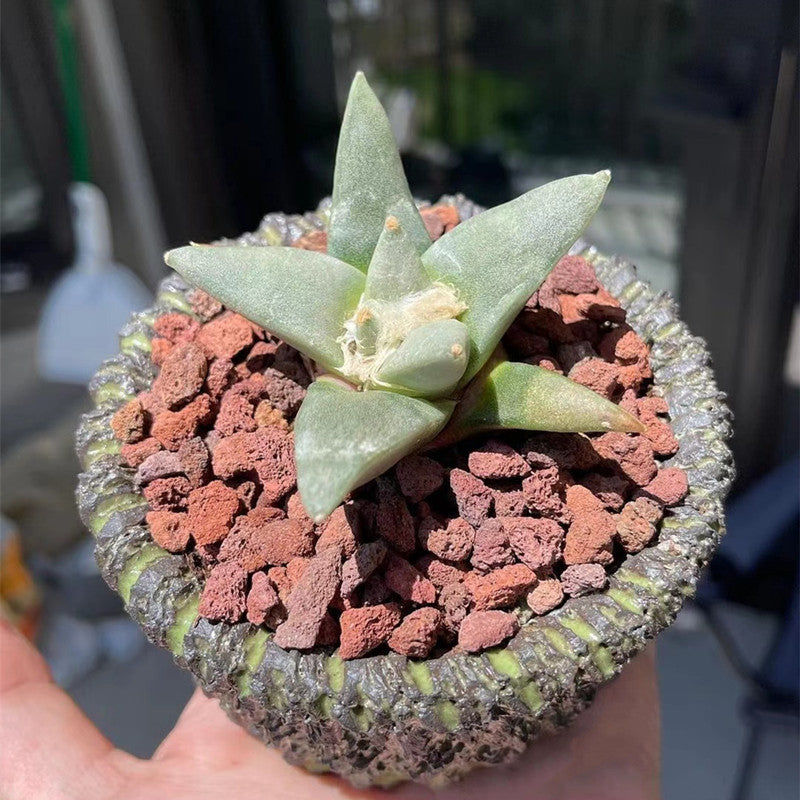Soil:
The ideal soil for Ariocarpus retusus Scheidw. is fertile soil containing coarse sand. The recommended planting medium ratio for horticultural plants is 50% heavy clay, 30% coarse sand, and 20% limestone fragments around 3mm in size. This soil mix, combined with coarse pottery clay pots, effectively meets the plant's root system's need for air and growth, ensuring the healthy growth of its fibrous roots. Specific adjustments can be made based on local climate conditions— for example, in dry and hot areas, increasing the proportion of clay while reducing the quantity and size of coarse sand can prevent rapid moisture loss from the medium. Additionally, some porous materials like pumice can be added to the medium as part of the coarse sand. A certain amount of slow-release potassium carbonate fertilizer can also be added, which is beneficial for Ariocarpus retusus Scheidw. cultivation.
Watering:
It's best to supplement water for Ariocarpus retusus Scheidw. by soaking the pot, with the amount of water added controlled to be absorbed within about 30 minutes. Soaking pots for water replenishment has two advantages: firstly, the "neck" of the plant does not become overly moist, thus avoiding the risk of root rot; secondly, it prevents the plant's hairs from tangling, maintaining its aesthetics. The only drawback of soaking pots is that it can cause salt crystals to form on the soil surface, but this can be removed by a small amount of misting or top watering.
The frequency of watering depends on various factors, such as the type of medium, the size of the medium's pores, temperature, and ventilation conditions, with the most crucial factor being whether the plant is in its growing season. Plants planted using the above-mentioned medium typically require watering every two weeks on average in a greenhouse environment from late March to mid-October (which is the growing season for Ariocarpus retusus Scheidw. plants). However, local climate conditions and the growth status of the plants should also be taken into consideration.
Ariocarpus retusus Scheidw. is a plant that grows seasonally. It enters a semi-dormant state in mid-summer, so it can be watered moderately according to this habit. From late spring to early summer and from late summer to before its flowering period, the demand for water by Ariocarpus retusus Scheidw. reaches its peak. If this period happens to coincide with hot and dry weather, the plants will dry out quickly, so they need to be watered every few days. After the flowering period, the plants generally enter a one-winter dormancy period starting from early November, during which they should be kept absolutely dry. In hot and dry climatic conditions, the plants will require more water, and their growth period, dormancy period, and flowering period will also be affected by their long growing season.
Fertilization:
It is best to fertilize simultaneously with watering. Soluble fertilizers containing rich potassium carbonate or a mixture of potassium phosphate and potassium carbonate added to the water are preferred.
Light:
For Ariocarpus retusus Scheidw. plants growing in northern Mexico, moderate sunlight intensity is particularly important for plant growth. In the wild, most Ariocarpus retusus Scheidw. plants are semi-buried in rocky soil, which effectively resists direct sunlight. Sunlight can keep the leaves tight and promote root development, ensuring healthy growth of the plants.
Generally, when newly potted, Ariocarpus retusus Scheidw. can be grown in a semi-shaded environment. When the light is too strong, shading must be done appropriately to prevent dehydration due to excessive light. Once the plants gradually recover, the intensity and duration of light can be increased according to the cultivation environment. For newly potted plants, strong light will quickly dehydrate them and may even cause death.
Temperature:
During the winter dormancy period, Ariocarpus retusus Scheidw. does not require high temperatures—temperatures above 4°C are sufficient if the potting soil is dry. The most challenging part is the two periods: from mid to late December and after the first watering in spring when the root system of the plant is not completely dry. In these cases, the temperature should be kept above 10°C.
Repotting:
Plastic flower pots are more conducive to the development of Ariocarpus retusus Scheidw. roots. Ariocarpus retusus Scheidw. planted in plastic flower pots will not have its hairy roots touching the side of the pot, which is more conducive to the development of its own root system. At the time of repotting, the plant should be taken out of the original pot, loose soil should be shaken off from the roots, and planting material should be filled in the circular gap at the bottom of the pot and around the bulb. Repotting Ariocarpus retusus Scheidw. every 2-3 years is helpful for its growth. Through repotting, the root system can be effectively relieved, and necessary nutrients can be added to the soil.
